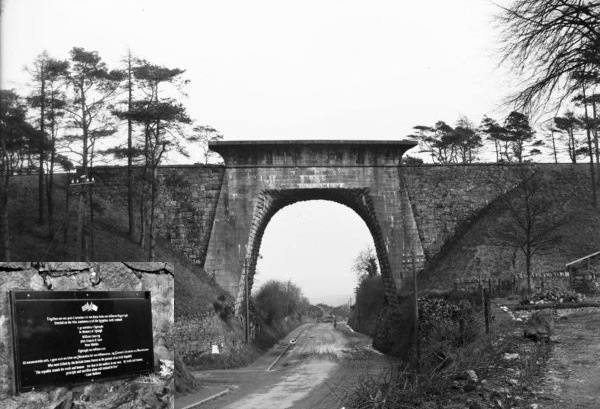
Sunday, December 12 marked the 101st anniversary of the Egyptian Arch ambush in Newry. An account by local republicans of a fateful night in which three IRA volunteers, William Canning, Peter Shields and John Francis O’Hare, lost their lives.
The plan was to attack the RIC barracks in Camlough and launch an ambush aimed at Crown Forces reinforcements coming from Newry, who would have to pass under the Arch.
The proximity of the Egyptian Arch to the main garrison town of Newry presented some difficulty to the Newry volunteers from the IRA’s 2nd Battalion – to block the road too early would arouse the enemy’s attention. So, just as the attack on the Camlough barracks was about to begin, the Newry volunteers quickly cut down the fir trees on either side of the railway embankment and made a roadblock under the arch, cutting the main road that the Crown Forces from the Newry garrison would need if they were to reach Camlough quickly. When the volunteers had finished blocking the road, they moved into firing positions on top of the Arch and waited.
At 11.30pm on Sunday, December 12, a large number of IRA volunteers, estimated at about 200 men from the Camlough and south Armagh area, moved into firing positions around the barracks. The volunteers had commandeered three of the four small houses opposite the barracks and quickly taken up positions at the upstairs windows.
About eight volunteers armed with rifles and hand grenades moved into position behind a low wall about eight feet from the barracks on the southern side. On the northern side, the volunteers had the most dangerous part of the operation. They had to insert a long gas pipe through an upstairs window in the barracks. The volunteers at this position were Frank Aiken, the officer in charge of the attack, Tommy O’Neill, the Camlough Battalion OC and Jack McIlhaw. At the western side of the barracks, it was not necessary to have any volunteers as there were no windows.
When all the IRA volunteers had taken up their positions at about midnight, the attack was started with the noise of the pipe breaking the window. This alerted the garrison, who immediately opened fire on the volunteers and sent up flares which lit up the whole area. A fierce volley of rifle fire was directed at the windows of the barrack to pin down any RIC men.
The British military garrison in Newry had seen the flares and a large force of 39 British soldiers and RIC personnel in Crossley Tenders and cars were sent to reinforce the Camlough garrison. When the military lorries reached the roadblock under the Egyptian Arch the volunteers on top, who had taken up their positions earlier, dropped grenades on the Crossley Tenders – two or three found their target but were thrown out before they could explode. Others exploded on the road.
As the British soldiers and RIC ran for cover in the fields on either side of the Arch, the volunteers opened up with a fusillade of revolver fire. A British soldier from one of the tenders at once opened fire with a machine gun, raking the top of the Arch. Volunteer William Canning from Ballymaclare, Magilligan’s Point in County Derry, who was employed by Cahill Brothers in Hill Street, Newry, was hit in the throat and head and died instantly. It was later admitted by the RIC that his body was thrown from the top of the Arch as “it was the quickest way to get it down”.
As the IRA unit was withdrawing, volunteer John Francis O’Hare from Needham Street, Newry, employed as a bookkeeper in Quinn’s the Milestone, Hill Street, was badly wounded and captured. He was taken to a British military hospital and kept there until July 15 1921. He died from his wounds on October 5 1921.
Also badly wounded in the withdrawal was volunteer Peter Shields from John Martin Street, but his comrades managed to help him to safety. He was taken to a shepherd’s hut outside Omeath for a while and then moved on to the Alexian Brothers. Shields died from his wounds on Christmas Day 1920 and was buried in an unmarked grave in Omeath.
After the volunteers had withdrawn from their positions on top of the Arch, the British army and RIC cleared the roadblock and went on to Camlough where they started raids and reprisals. Over half the village was burned that night.
![[Irish Republican News]](https://republican-news.org/graphics/title_gifs/rn.gif)
![[Irish Republican News]](https://republican-news.org/graphics/title_gifs/harp.gif)

